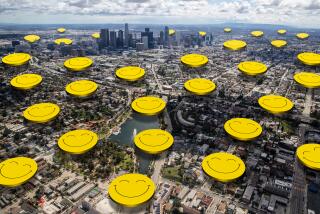‘Bubble Gum Alley’ Disgusts and Delights Visitors
SAN LUIS OBISPO — As cultural monuments go, Bubble Gum Alley has proven its staying power. Like a wad of Bazooka Joe stubbornly stuck on a shoe, it has hung on for almost 50 years.
“On a regular day, we get about 300 to 400 visitors,” said James Anderson, the assistant director of information services for the Chamber of Commerce. There’s always “a handful” who say their visit wouldn’t be complete without a trip down Bubble Gum Alley.
And proving that bad manners is a universal language, many of those searching out the alley in this conservative community are visitors from abroad. The word most associated with the alley, in fact, means the same thing no matter what country you’re in.
That word is “eeew.”
“It’s kind of disgusting,” said Lauren Tobin, 21, as she scanned the gum-covered walls. Taking a shot at the local Cal Poly students, the biology student from UC Davis said, “It probably reflects the student population.”
As the name implies, Bubble Gum Alley is an alley in which the facing walls of two downtown commercial buildings are encrusted with gum. It doesn’t resemble anything but what it is, tens of thousands of wads of multicolored gum squished one on top of another in a masticated mosaic 70 feet long and 15 feet high. At the top, the gobs have been blackened by age and weather.
Some have left messages in mucilage: “Jesus Loves,” “Porky,” and the sweetly simple “Hi.”
Others have used the brick facades as canvases for their artworks. There are flowers, an American flag and several impressionistic figures that may or may not be human forms. Two cigarette butts protrude from one gummy mass, embracing at once the two oral habits that mothers warned generations of children against.
The city’s historical society says the genesis is sketchy, but the alley was created sometime in the 1950s. High school students started putting gum on the walls, Cal Poly students soon followed suit, and by the ‘60s the alley had become part of the local color.
Over the years, San Luis Obispo’s attitude toward Bubble Gum Alley has vacillated. On one hand, the Chamber of Commerce lists it as a “special attraction,” and the city has posted a sign on the site. On the other, residents have periodically united in anti-gum crusades.
“One year, the fire department hosed it down,” said Deborah Holley, administrator of the Downtown Assn. Instead of just falling down and washing away, thousands of pieces of old gum shot high into the sky. People ran waving their arms from a gum-storm that day, Holley said.
Holley entered Gum Alley in a national civic competition for unusual community monuments a few years back. A banquet room in Portland, Ore., was filled with representatives of hundreds of cities when pictures of the alley flashed on the screen.
“Eeew, gross,” the audience said in unison.
It’s hard to say what Bubble Gum Alley says about San Luis Obispo, or gum, for that matter. Maybe it says something about the stubbornness of local traditions, because the alley seems here to stay.
“It’s interesting to watch tourists,” said Holley. “There’s this attraction-repulsion thing.”
You could see it in the face of Ryan Norton, 24, of Los Angeles. He and his 23-year-old wife, Angela, were in town on a recent afternoon celebrating their first anniversary.
To him, the alley was equal parts fun and disgusting; his wife pronounced it “great. I don’t know if it’s an expression of art. Maybe this will keep people from throwing their gum on the ground.”
Ryan Norton overcame his repulsion and decided the couple should leave their own mark on the wall. And so, as they plighted their troth, they merged their gum. Stooping, he etched their initials in the wad with a piece of broken glass he found on the asphalt.
“We’ll come back every year and put our gum here,” he proclaimed.
As anniversary traditions go, it might not be the most elevating, or hygienic. But the walls of gum have already outlasted many marriages.
More to Read
The biggest entertainment stories
Get our big stories about Hollywood, film, television, music, arts, culture and more right in your inbox as soon as they publish.
You may occasionally receive promotional content from the Los Angeles Times.










